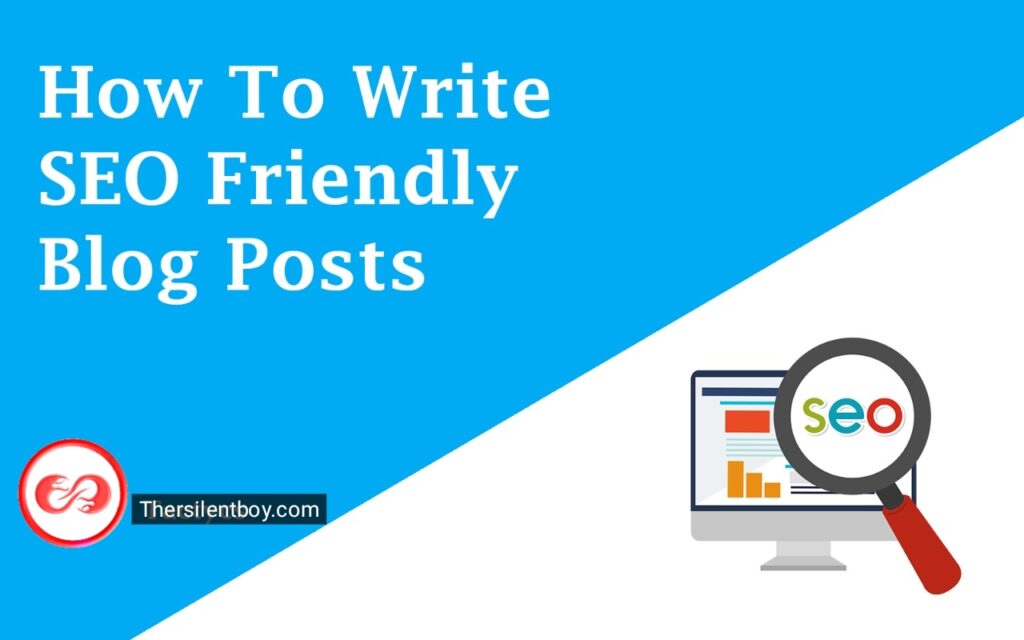
Intro:- How to Write SEO-Friendly Blog Posts? for SEO-Friendly Blog Post. …
- Think before you start writing
- Create the structure of the blog post
- Craft the title and URL
- Use headings correctly
- Keep your paragraphs short
- Add links when it makes sense
- Do make use of keywords ( but not keyword stuffing)
- Optimize the length of your blog post
- Optimize your meta description
- Optimize your images and other media elements.

Unpaid traffic may originate from different kinds of searches, including image search, video search, academic search, news search, and industry-specific vertical search engines.
About:- Search engine optimization is the process of improving the quality and quantity of website traffic to a website or a web page from search engines. SEO targets unpaid traffic rather than direct traffic or paid traffic.
What is SEO and how does it work? Well, SEO stands for “Search Engine Optimization”, which is the process of getting traffic for free, organic, editorial, or natural search results in search engines. It aims to improve your website’s position in search results pages. Remember, the higher the website is listed, the more people will see it.
How to Write SEO-Friendly Blog Posts? If you are reading this article that means you want to know about “How to write SEO-Friendly Blog Posts”, right? But, you don’t have any idea how or where to start. If you are looking for an easy guide on how to write SEO-Friendly blog posts, then you are at the right place. Just you have to read this article properly. In this article, I will show you a step-by-step tutorial on how to write SEO-Friendly blog posts. Even if you are a beginner there is no worry about it. The steps below are meant for both beginners & experts.
But before beginning to start a blog, there is some major point that you should know, like what is SEO, what is the purpose of SEO, What is an algorithm in SEO & is the difference between SEO and Marketing? Let’s Find it Out.
1. What is SEO( Search Engine Optimization )?

SEO stands for Search Engine Optimization, which is the practice of increasing the quantity and quality of traffic to your website through organic search engine results.
2. What is the Purpose of SEO?
SEO is all about optimizing a website for search engines. SEO is a technique for designing and developing a website to rank well in search engine results. improving the volume and quality of traffic to a website from search engines. marketing by understanding how search algorithms work, and what human visitors might search.
3. What is an algorithm in SEO?
An algorithm is a series of operations a search engine uses to calculate and rank websites based on when someone uses a specific search query. You may have heard algorithms are always changing, and, to some degree, that’s true.
4. What is the difference between SEO & Marketing?
Marketing by understanding how search algorithms work, and what human visitors might search. SEO is a subset of search engine marketing. SEO is also referred to as SEO copyrighting, because most of the techniques that are used to promote sites in search engines, deal with text.
Let's Start;
Blogging is a fantastic way to improve your brand’s online visibility. However, only a selected number of blogs make their way onto Google’s first page. If you want to be one of them, you should follow certain SEO techniques to write search-friendly blogs. In this article, I’ll show you “how to write SEO-Friendly blog posts to increase your ranking potential and organic traffic on your blog posts with 8 easy-to-follow methods.
Table of Contents
8 Effective Tips to write SEO-Friendly Blog Posts.
- Start with keyword research
- Find the idle length of the article
- Add Appropriate heading tags
- Focus on Internal Linking
- Add post meta description
- Use keywords in image Alt Text
- Write High-Quality Content
- Remove STOP words from the URL
8 Effective Tips to Write SEO-Friendly Blog Posts.
1. Start with Keyword research
Keywords are the foundation of writing blog posts for search engine optimization. They’re what help readers find what they’re looking for which you can then use for future posts. Before you start writing, do a bit of keyword research to figure out which set of words your target audience frequently uses. Have a list of primary keywords and secondary keywords, and try to naturally incorporate keywords into your content and keyword stuffing.
2. Find the idle length of the article
Make sure your blog/article posts have a minimum word count of 500 words. Long-form content tends to rank better on Google’s search engine due to its completeness in covering a topic and subtopics. But keep in mind that quality is better than quantity. If you can answer a specific question in 500 words or less, do so. However, to make your blog content more interesting, consider adding extra information relevant to the topic until you reach at least 500-3000 words.
3. Add Appropriate Heading Tags
Heading tags help Google identify the structure of your page. Think of it like a table of contents that search engines can use to see the content of each page at a glance. When Google wants to pull information for a featured snippet, it will refer to keywords as well as heading tags to identify the intent and content of your page. If you want that #1 ranking, make sure your headings are specific and incorporate your keywords where appropriate. Specific headings are not only useful for SEO, but they also make content reader-friendly, thereby improving the user experience.
4. Focus on Internal & External Linking
Adding internal and external links to your site and high-authority websites helps improve the usefulness of your content and signals to search engines like Google that you’ve done your research. Internal links also increase the potential for better rankings for your content and can enhance the user experience by providing additional resources and site navigation.
5. Add Post Meta Description
If you’re not adding meta descriptions to your posts, you’re giving them the potential exposure it deserves. While Google Search often changes meta descriptions based on the content found on a page or post, it’s still a good idea to add a custom description. Meta descriptions give readers a brief description of your blog post. Keep it short but compelling; your meta descriptions should be out from other similar-topic posts. In addition, incorporate your main keyword in your blog post’s meta description and do your best to describe the page topic to encourage Google to use your description.
6. Use Keywords in Image Alt Text
Images are an important asset for all web pages. They make a page easier to read, and more visually attractive and they help in presenting a topic better. Having a good alt attribute to all your images improves the accessibility of a site and also helps SEO both for image search and web search.
7. Write High-Quality Content
Aim to produce high-quality content. A well-optimized blog post is organized for search engine crawlers and includes headings and subheadings related to the topic. Use short sentences, but add a bit of variety to their lengths through writing naturally. Most importantly, optimized blog posts add value to the topics you’re writing about and more so than competing posts found on search engine results pages(SERPs). Utilize tools like Grammarly to check for spelling and grammar errors and an on-page optimization tool like surfer SEO to optimize your copy based on top-ranking pages.
8. Remove STOP words from the URL
Stop Words: A stop word is a commonly used word(such as “the”, “a”, “?”, “an”, “in”) that a search engine has been programmed to ignore, both when indexing entries for searching and when retrieving them as the result of a search query.
Conclusion
Above we have seen 8-actionable tips on how to write SEO-Friendly blog posts to rank higher in search results and improve your website’s organic to rank higher in search results and improve your website’s organic traffic potential. By applying these strategies, you’re writing blogs your readers and Google favor. With a bit of consistency and dedication, more of your blog posts will rank on the first page of Google before you know it.
- If you got this article helpful leave a comment below in the comment box. I will try to give you an answer. And Thanks for reading the Article!

Authored By The Er. Pramod Adhikari!
The Blogger, Author & CEO’s The Infinity Company! B. Tech in CSE(Computer Science & Engineering) from Sambhram College, Bengaluru-560097, Working worldwide as Software(Web/App) Developer!

